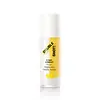What's inside
What's inside
 Key Ingredients
Key Ingredients

 Benefits
Benefits

 Concerns
Concerns

 Ingredients Side-by-side
Ingredients Side-by-side

Water
Skin ConditioningGlycerin
HumectantNiacinamide
Smoothing1,2-Hexanediol
Skin ConditioningHydroxyacetophenone
AntioxidantAcrylates/C10-30 Alkyl Acrylate Crosspolymer
Emulsion StabilisingPEG/PPG-14/7 Dimethyl Ether
Skin ConditioningPEG-40 Hydrogenated Castor Oil
EmulsifyingSodium Hydroxide
Buffering3-O-Ethyl Ascorbic Acid
Skin ConditioningAscorbyl Glucoside
AntioxidantUndecylenoyl Phenylalanine
Skin ConditioningAllantoin
Skin ConditioningXanthan Gum
EmulsifyingButylene Glycol
HumectantCitrus Aurantium Bergamia Fruit Oil
MaskingPaeonia Albiflora Root Extract
Skin ConditioningCitrus Junos Fruit Extract
Skin ConditioningMaltodextrin
AbsorbentCentella Asiatica Leaf Extract
Skin ConditioningCaprylic/Capric Triglyceride
MaskingSucrose Polystearate
EmollientBisabolol
MaskingPhytosteryl Isostearate
Skin ConditioningRetinyl Palmitate
Skin ConditioningPotassium Cetyl Phosphate
EmulsifyingTocopherol
AntioxidantWater, Glycerin, Niacinamide, 1,2-Hexanediol, Hydroxyacetophenone, Acrylates/C10-30 Alkyl Acrylate Crosspolymer, PEG/PPG-14/7 Dimethyl Ether, PEG-40 Hydrogenated Castor Oil, Sodium Hydroxide, 3-O-Ethyl Ascorbic Acid, Ascorbyl Glucoside, Undecylenoyl Phenylalanine, Allantoin, Xanthan Gum, Butylene Glycol, Citrus Aurantium Bergamia Fruit Oil, Paeonia Albiflora Root Extract, Citrus Junos Fruit Extract, Maltodextrin, Centella Asiatica Leaf Extract, Caprylic/Capric Triglyceride, Sucrose Polystearate, Bisabolol, Phytosteryl Isostearate, Retinyl Palmitate, Potassium Cetyl Phosphate, Tocopherol
Aronia Melanocarpa Fruit Extract
Skin ConditioningButylene Glycol
HumectantPropanediol
SolventBetaine
HumectantPanthenol
Skin ConditioningNiacinamide
Smoothing1,2-Hexanediol
Skin ConditioningAscorbyl Tetraisopalmitate
AntioxidantHydroxyethyl Acrylate/Sodium Acryloyldimethyl Taurate Copolymer
Emulsion StabilisingCetearyl Olivate
Sorbitan Olivate
EmulsifyingAllantoin
Skin ConditioningTocopherol
AntioxidantAdenosine
Skin ConditioningSodium Hyaluronate
HumectantBakuchiol
AntimicrobialAlpha-Arbutin
AntioxidantFerulic Acid
AntimicrobialCentella Asiatica Oil
AntimicrobialGlycine Soja Oil
EmollientAronia Melanocarpa Fruit Extract, Butylene Glycol, Propanediol, Betaine, Panthenol, Niacinamide, 1,2-Hexanediol, Ascorbyl Tetraisopalmitate, Hydroxyethyl Acrylate/Sodium Acryloyldimethyl Taurate Copolymer, Cetearyl Olivate, Sorbitan Olivate, Allantoin, Tocopherol, Adenosine, Sodium Hyaluronate, Bakuchiol, Alpha-Arbutin, Ferulic Acid, Centella Asiatica Oil, Glycine Soja Oil
 Reviews
Reviews

Ingredients Explained
These ingredients are found in both products.
Ingredients higher up in an ingredient list are typically present in a larger amount.
1,2-Hexanediol is a synthetic liquid and another multi-functional powerhouse.
It is a:
- Humectant, drawing moisture into the skin
- Emollient, helping to soften skin
- Solvent, dispersing and stabilizing formulas
- Preservative booster, enhancing the antimicrobial activity of other preservatives
Allantoin is a soothing ingredient known for its protective and moisturizingg properties. Because of this, it is often added to products with strong active ingredients.
Studies show higher concentrations of this ingredient can promote wound healing.
Though it can be derived from the comfrey plant, allantoin is produced synthetically for cosmetic products to ensure purity.
Learn more about AllantoinButylene Glycol (or BG) is used within cosmetic products for a few different reasons:
Overall, Butylene Glycol is a safe and well-rounded ingredient that works well with other ingredients.
Though this ingredient works well with most skin types, some people with sensitive skin may experience a reaction such as allergic rashes, closed comedones, or itchiness.
Learn more about Butylene GlycolNiacinamide is a multitasking form of vitamin B3 that strengthens the skin barrier, reduces pores and dark spots, regulates oil, and improves signs of aging.
And the best part? It's gentle and well-tolerated by most skin types, including sensitive and reactive skin.
You might have heard of "niacin flush", or the reddening of skin that causes itchiness. Niacinamide has not been found to cause this.
In very rare cases, some individuals may not be able to tolerate niacinamide at all or experience an allergic reaction to it.
If you are experiencing flaking, irritation, and dryness with this ingredient, be sure to double check all your products as this ingredient can be found in all categories of skincare.
When incorporating niacinamide into your routine, look out for concentration amounts. Typically, 5% niacinamide provides benefits such as fading dark spots. However, if you have sensitive skin, it is better to begin with a smaller concentration.
When you apply niacinamide to your skin, your body converts it into nicotinamide adenine dinucleotide (NAD). NAD is an essential coenzyme that is already found in your cells as "fuel" and powers countless biological processes.
In your skin, NAD helps repair cell damage, produce new healthy cells, support collagen production, strengthen the skin barrier, and fight environmental stressors (like UV and pollution).
Our natural NAD levels start to decline with age, leading to slower skin repair, visible aging, and a weaker skin barrier. By providing your skin niacinamide, you're recharging your skin's NAD levels. This leads to stronger, healthier, and younger looking skin.
Another name for vitamin B3 is nicotinamide. This vitamin is water-soluble and our bodies don't store it. We obtain Vitamin B3 from either food or skincare. Meat, fish, wheat, yeast, and leafy greens contain vitamin B3.
The type of niacinamide used in skincare is synthetically created.
Learn more about NiacinamideTocopherol (also known as Vitamin E) is a common antioxidant used to help protect the skin from free-radicals and strengthen the skin barrier. It's also fat soluble - this means our skin is great at absorbing it.
Vitamin E also helps keep your natural skin lipids healthy. Your lipid skin barrier naturally consists of lipids, ceramides, and fatty acids. Vitamin E offers extra protection for your skin’s lipid barrier, keeping your skin healthy and nourished.
Another benefit is a bit of UV protection. Vitamin E helps reduce the damage caused by UVB rays. (It should not replace your sunscreen). Combining it with Vitamin C can decrease sunburned cells and hyperpigmentation after UV exposure.
You might have noticed Vitamin E + C often paired together. This is because it is great at stabilizing Vitamin C. Using the two together helps increase the effectiveness of both ingredients.
There are often claims that Vitamin E can reduce/prevent scarring, but these claims haven't been confirmed by scientific research.
Learn more about Tocopherol